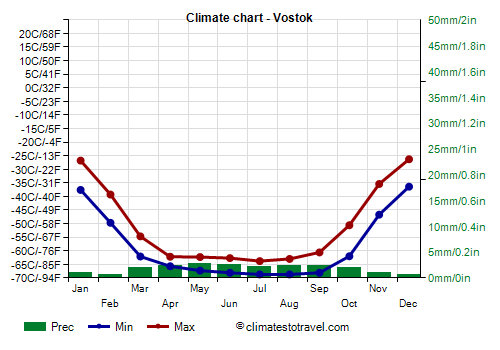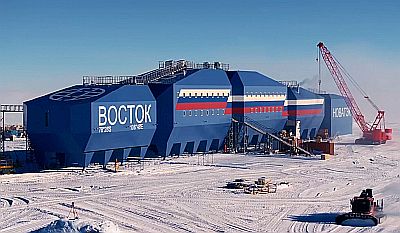Select units of measurement for the temperature and rainfall tables (metric or imperial).
Average weather, temperature, rainfall, sunshine hours

At the Antarctic station of Vostok ("East" in Russian) the climate is
polar, with extremely low temperatures and always below freezing.
The station was founded in 1957 by the Soviet Union, and was renovated, with new prefabricated buildings, in 2023. The station is located approximately 1,300 km (800 mi away) from the South Pole, at 78 degrees south latitude and 3,490 meters (11,450 ft) above sea level. The altitude is so high because a thick
layer of ice has formed over the millennia.
We are on the East Antarctic plateau, the coldest and driest area of the continent, the one furthest from the sea (which is at least 1,260 km or 780 mi away) and where the altitude is highest.
In fact, the average annual
temperature is -54.5 °C (-66 °F), and is a few degrees lower than at the South Pole, which is located at 2,835 meters (9,300 feet) above sea level. All year round, a strong thermal inversion occurs, so the temperature on the ground is lower than at higher altitudes.
As also happens at the pole, summer lasts only two months, December and January, then, with the sun's descent above the horizon, the temperature decreases rapidly in autumn, in February and March. Instead, in the coldest period, from April to September, which can be considered as winter, the temperature stabilizes, also due to the change in atmospheric circulation, so much so that from April to July it decreases by only 2 degrees Celsius (3.6 °F).
Vostok station holds the
world cold record, -89.2 °C (-128.6 °F), set in July 1983. After 2000, however, the temperature "only" dropped to -85 °C (-121 °F).
It must be said that satellite measurements have detected lower temperatures at sites located even further from the sea than the Vostok station.
The highest temperature was -13.6 °C (7.5 °F), recorded in December 1957.
Here are the average temperatures.
Vostok - Average temperatures (2000-2020) |
| Month | Min | Max | Mean |
|---|
| January | -37.6 | -26.8 | -32.2 |
|---|
| February | -49.7 | -39.3 | -44.5 |
|---|
| March | -62.1 | -54.7 | -58.4 |
|---|
| April | -65.7 | -62.2 | -64 |
|---|
| May | -67.3 | -62.3 | -64.8 |
|---|
| June | -68.1 | -62.7 | -65.4 |
|---|
| July | -68.7 | -63.8 | -66.2 |
|---|
| August | -68.7 | -63 | -65.8 |
|---|
| September | -68.1 | -60.6 | -64.4 |
|---|
| October | -62 | -50.6 | -56.3 |
|---|
| November | -46.7 | -35.4 | -41 |
|---|
| December | -36.4 | -26.3 | -31.4 |
|---|
| Year | -58.5 | -50.7 | -54.45 |
|---|
The average relative humidity is 71%, while the absolute humidity is very low, because when it is very cold, the air can contain little water vapor.
The
precipitation measured is very low, just 22 millimeters (0.85 inches) per year, even though the real estimated quantity is 38 mm (1.5 in).
In fact, the amount of
snow that actually falls can only be estimated, because some of it is carried away by the wind. However, this happens much less than in other areas of Antarctica, where it snows more, and the wind is stronger and more frequent as well.
On average, there are 35 days a year with
fog and 150 with
mist, in both cases with a minimum in summer. Fog and mist are made up of ice crystals suspended in the air, some of which can settle on the ground due to gravity. The small ice crystals, called "diamond dust", can form even with clear skies, due to the direct condensation of the little humidity present in the air. Or
frost can form directly on the ground.
On average, there are only 26 days with snow and sleet, most of which occur in the cold period, from May to October, but there are 247 days in which that often very light precipitation of ice needles occurs.
Snow does not melt because the temperature never rises above freezing, however, the tiny ice needles can evaporate, or even partially melt in summer under the sun's rays, and then refreeze and turn into a crust on top of the already existing ice layer.
Here is the average precipitation.
Vostok - Average precipitation| Month | Days |
|---|
| January | 1 | |
|---|
| February | 1 | |
|---|
| March | 2 | |
|---|
| April | 2 | |
|---|
| May | 3 | |
|---|
| June | 2 | |
|---|
| July | 2 | |
|---|
| August | 2 | |
|---|
| September | 2 | |
|---|
| October | 2 | |
|---|
| November | 1 | |
|---|
| December | 1 | |
|---|
| Year | 20 | |
|---|
The
wind at Vostok station blows often, although with less intensity than in the peripheral areas of Antarctica. The average wind speed is 18 kph (11 mph). The wind blows mainly from the south-west, that is, from the highest part of the plateau, the coldest one, where the site called "Dome A" is located, at 4,000 meters (13,000 ft) above sea level. So the wind often has a slightly downward characteristic, which tends to bring a little lower humidity than would normally occur at these temperatures, and clear skies.
However, there may also be periods of bad weather, although stormy winds are rare. The strongest gust ever recorded was 115 kph (71.5 mph). In strong wind conditions, with snow raised by the wind, visibility is reduced to zero.

The
sunshine amount at Vostok station is overall excellent. In fact, with 3,760 hours of sunshine per year, we are in one of the sunniest areas of the planet, close to the world records set in the deserts of North America and eastern Sahara. Unlike the latter, however, the sun does not shine all year round, as there are some months of darkness. In December, there are even 22.9 hours of sunshine per day, out of 24 available, and this is a world record for a single month. Here is the average number of sunshine hours per day.
Vostok - Sunshine hours| Month | Average | Total |
|---|
| January | 22.5 | 695 |
|---|
| February | 20 | 565 |
|---|
| March | 11 | 345 |
|---|
| April | 2.5 | 75 |
|---|
| May | 0 | 0 |
|---|
| June | 0 | 0 |
|---|
| July | 0 | 0 |
|---|
| August | 0 | 0 |
|---|
| September | 7 | 205 |
|---|
| October | 15.5 | 480 |
|---|
| November | 22.5 | 680 |
|---|
| December | 23 | 710 |
|---|
| Year | 10.3 | 3760 |
|---|
Compared to the South Pole, in the Vostok station the
polar night, in which the sun never rises, is shorter, about four months, and goes from April 23rd to August 19th. It must be said that for a few weeks, at the beginning and at the end of this period, the sun approaches the horizon around midday (or rather around 11 in the morning given the time zone adopted), providing some light.
The
polar day, in which the sun never sets, also lasts four months, and runs from October 21st to February 20th.
At the summer solstice, December 21st or 22nd, at midday the sun reaches 35 degrees above the horizon, that is, 11 and a half degrees higher than at the South Pole.
In this and other Antarctic stations, with an icy surface, scientists carry out
ice core samples to study the chemical and physical composition of the ice layers that have accumulated over the millennia. This allows us to reconstruct the climate of the past, up to about 500,000 years ago.
In 2012, Russian scientists drilled through the entire ice layer, and starting from 3,768 meters (12,362 ft) deep, therefore below sea level, they found a freshwater lake,
Lake Vostok, where the water is in a liquid state due to pressure, even though the water temperature is -3 °C (26.5 °F).
The lake has an average depth of 432 meters (1,417 ft), this means that if there were neither the lake nor the ice on it, the earth's surface would be 500 meters (1,640 ft) below sea level. However, it is also true that if there were not the enormous ice cap that weighs on the continent, the ground would tend to rise a little.